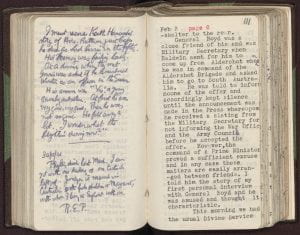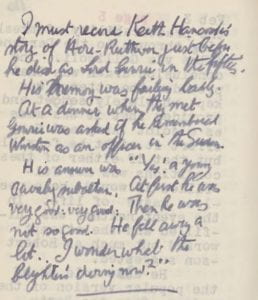Diary Entry Dated February 3rd, 1935
Christopher Orrell

To some a diary may serve as a memory aid, or as a place to collect their innermost thoughts. To others it may function as a type of autobiography, written for an audience with the intention of future publication. Raymond Priestley’s diary is of this latter type. It records the daily happenings of Priestley’s life but they carry the conviction that they will at some time be presented to future readers. Indeed, the diaries were eventually edited and published as The Diary of a Vice-Chancellor.[1]While known at the University of Melbourne as its first professional Vice-Chancellor, Priestley was a remarkable man with a long and varied career. The entry dated February 3rd, 1935, presents him differently: this is not about Priestley the Antarctic explorer, nor military signals officer, nor the knight bachelor. Rather, two hand written notes provide a glimpse of Priestley the person.
The diary here recounts a mundane day on Priestley’s voyage to Australia in which he celebrates a new friend’s birthday; lends some books on polar exploration to a bellboy; swaps war stories with Alexander Hore-Ruthven, 1st Earl of Gowrie; reads and takes some photographs. An uneventful, but nonetheless interesting passing of time on board the ship.
Opposite page 111 are a pair of explanatory notes that do not appear in the published version. Both were written much later: the first sometime after May 2nd, 1955 but before October 30th, 1961; the second is dated October 30th, 1961.[2] Priestley’s loopy handwriting is rather difficult to read, and decoding it involved cross-referencing against other sources. Lord Gowrie’s name emerged from a mention of his wife, Lady Hore-Ruthven, in an earlier typed entry. A short biography of Lord Gowrie then assisted in decoding the rest of the text. Some parts, such as the name ‘Keith Hancock’, proved difficult to decode and are educated guesses.
It is a humorous anecdote about Lord Gowrie, who Priestley had chatted with on that February day as they travelled from Cape Town to Melbourne. At the time of their meeting, Priestley had already been appointed Vice-Chancellor of the University of Melbourne,[3] and Lord Gowrie was about to take up a new role as Governor of New South Wales.[4] It reads:
‘I must record Keith Hancock’s story of Hore-Ruthven just before he died as Lord Gowrie in the fifties. His memory was failing badly. At a dinner when they met Gowrie was asked if he remembered Winston [Churchill] as an officer in the Sudan. His answer was “Yes! A young cavalry subaltern. At first he was very good, very good. Then he was not so good. He fell away a lot. I wonder what the blighter’s doing now?”’

Hore-Ruthven died in 1955. At the time he would have said this, Winston Churchill was serving his second term as the Prime Minister of the United Kingdom. Truly a ridiculous thing to forget!
Juxtaposed with this humorous note, the second note, dated 31/10/61, is altogether more sombre. It reads:
‘Phyllis died last March. I am 75 with one kidney and one testicle left only. Jocelyn is married in Australia with four children and Margaret, with whom I live, in England with one.’
The words are those of profound sadness. Priestley seems to have been motivated by his grief at the death of his wife Phyllis to write this note and insert it into his diary. While it is not in the published version, it resides in the original document to inform his future researcher of the fates of himself and his daughters. Unlike the humorous note above, this report on his health and progeny bears no relation to the text of the accompanying diary entry. Its brevity conjures images of a grieving Priestley reflecting on what is left of a human life. Above all, it shows that despite the accolades, behind the success, Priestley was a living, feeling person just like you or I.

Christopher Orrell is currently undertaking a Master of Arts by research in the School of Historical and Philosophical Studies at the University of Melbourne. His thesis examines the communication of medical knowledge in mid-nineteenth century Victoria.
References
[1] Ronald Ridley (ed), The Diary of a Vice Chancellor: University of Melbourne 1935-1938, (Melbourne: Melbourne University Press, 2002). This book is worth a look if you are interested in finding out more about Priestley’s time in Melbourne. It includes a comprehensive index and a list of the prominent people in the diary.
[2] Raymond Priestley, Australian Diary Volume 1, p.111. University of Melbourne Archives, Sir Raymond Edward Priestley (1884-1979) Collection, 1973.0079, 1/1.
[3] The first entry in the diary, January 1st 1935, mentions that Priestley’s appointment as Vice-Chancellor started at midnight, Melbourne time. His previous appointment at Cambridge ended at midnight GMT, which he notes ‘for a few hours [he] was in the happy position of drawing two stipends but doing nothing to earn either’. Raymond Priestley, Australian Diary Volume 1, p.1. University of Melbourne Archives, Sir Raymond Edward Priestley (1884-1979) Collection, 1973.0079, 1/1.
[4] Priestley elsewhere refers to Lord Gowrie by his proper referential title: in 1935 he is ‘His Excellency’ and in the post-1955 note he is ‘Lord Gowrie’, ‘Gowrie’ or ‘Hore-Ruthven’.
Leave a Reply